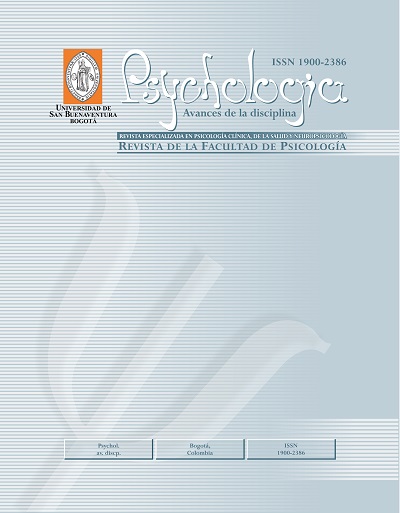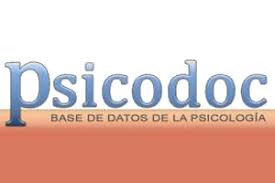View/Download
How to Cite
García Ortiz, L., Arcila Bonfante, Z., & Medina Vásquez, S. (2017). Neuropsychological profile in a 50-year-old patient with tuberculosis/HIV coinfection. Psychologia, 11(2), 85–98. https://doi.org/10.21500/19002386.2927
More Citation Formats
License terms
▼
This journal provides open, immediate access to its contents, based on the principle that offering the public free access to research helps to promote a higher global exchange of knowledge.
As such, all journal articles are published under a Creative Commons Attribution-NonCommercial-ShareAlike 4.0 International License (CC BY-NC-SA), by which commercial use of the original work or its possible derived works is not allowed, and the distribution thereof must be done with the same license elements regulating the original work.
http://creativecommons.org/licenses/by-nc-sa/4.0/
Abstract
The Human Immunodeficiency Virus (HIV) is a virus that invades the immune system causing it to weaken and unable to defend the body from invading infectious organisms. This factor is used by the opportunistic diseases, being tuberculosis (TBC), one of the most prevalent in patients with HIV. TBC/HIV coninfection causes a progressive deterioration of the immune system, neurological aftermath and neuropsychological alterations. The purpose of this study is to describe the neuropsychological profile of an 50 year old man with HIV and an opportunistic disease (TBC). For the neuropsychological evaluation were used subtests of the Test Barcelona, the NEURONORMA and the BANFE-2. The results suggested a prefrontal syndrome with greater alteration of the dorsolateral and orbital circuits. This study stimulates research that amplifies information about the differential neuropsychological aftermath of HIV and TBC, as well as those resulting from its interaction.
Keywords:
References
Alberca, R. y López-Pousa, S. (2011). Enfermedad de Alzheimer y otras Demencias. Madrid, España: Médica Panamericana.
Amarillas, A., Conner, A., Akers, D., Solomon, J., Ralph J. y DiClemente, J. (2008). The Complete HIV/AIDS. New York, Estados Unidos: Publishing Company.
Anand, P., Springer, S., Copenhaver, M. y Altice, F. (2010). Neurocognitive Impairment and HIV Risk Factors: A Reciprocal Relationship. AIDS Behav, 58, 1213-1226.
Arciniegas, A. y Malagón, K. (2013). Funciones Cognitivas de Individuos Positivos para
VIH/SIDA Asistentes a un Programa de Atención Integral. Universidad Del Rosario.
Ayuso, J. (1997). Trastornos neuropsiquiátricos en el SIDA. España: McGraw-Hill - Interamericana.
Bauselas, E. y Santos, C. (2006). Disfunción Ejecutiva: Sintomatología que Acompaña a la Lesión y/o Disfunción del Lóbulo Frontal. Revista Internacional, 5(2), 1-15.
Bragança, M. y Palha, A. (2011). Trastornos neurocognitivos asociados con la infección por el VIH. Actas Españolas de Psiquiatría, 39(6), 374-83.
Carey, C., Woods, S., Rippeth, J., González, R., Moore, D. y Marcotte, T. (2004). Initial validation of a screening bat- tery for the detection of HIV-associated cognitive impairment. The Clinical Neuropsychologist, 18(2), 234-248.
Cattie, J. E., Doyle, K., Weber, E., Grant, I. y Woods, S. (2012). Planning deficits in HIV-associated neurocognitive disorders: Component processes, cognitive correlates, and implications for everyday functioning. Journal of Clinical and Experimental Neuropsychology, 34(9), 906-918.
Coffin, J. y Swanstrom, R. (2013). HIV pathogenesis: dynamics and genetics of viral populations and infected cells. PudMed Journals, 3(1). Doi: 10.1101/cshperspect.a012526.
Cuevas, M., y Pérez, J. (2002). Deterioro y evaluación neuropsicológicos en pacientes con infección por el virus de inmunodeficiencia humana (VIH-1): estado de la cuestión. Clínica y Salud, 13(1), 57-87.
Damasio, A. (1998). The somatic marker hypothesis and the possible functions of the prefrontal cortex.
Dawes, S., Suarez, P., Casey, C., Cherner, M., Marcotte, T. y Letendre, S. (2008). Variable patterns of neuropsycho- logical performance in HIV-1 infection. Journal of Clinical and Experimental Neuropsychology, 30(6), 613-626.
Delgado, J., Castrillón, J., Rascovsky, S., García, L., Vélez, J. y Calvo, V. (2012). Cambios cerebrales en la morfometría en pacientes con VIH. Revista Colombiana de Psiquiatría, 41(3), 473-484.
Devinsky, O., Morrell, M. y Brent, A. (1995). Contribution of anterior cingulate cortex to behavior, 118, 279-306.
Doyle, K., Weber, E., Atkinson, J., Grant, I. y Woods, S. (2012). Aging, prospective memory, and health-related quality of life in HIV infection. AIDS and Behavior, 16(8), 2309-2318.
Edo, T. y Ballester, R. (2006). Estado emocional y conducta de enfermedad en pacientes con VIH/SIDA y enfermos oncológicos. Revista de Psicopatología y Psicología Clínica, 11(2), 79-90.
García, T., Vergara, M., Piñón, B. y Pérez, G. (2015). Alteraciones neuropsicológicas en pacientes con VIH e historia previa de consumo de sustancias. Revista Latinoamérica de Psicologia, 47(3), 213-221.
Ghafouri, M., Amini, S., Khalili, K. y Sawaya, B. (2006). HIV-1 associated dementia: symptoms and causes. Retrovirology, 19(3), 28.
Grant, I., Marcotte, T. y Heaton, R. (1999). Neurocognitive complications of HIV disease. Psychological Science, 10(3), 191-195.
Hassmiller, K. (2006). The association between smoking and tuberculosis. Salud Pública de México. Recuperado de http://www.scielosp.org/scielo.php?script=sci_arttext&pid=S0036-36342006000700024
Heaton, R., Grant, I., Butters, N., White, D., Kirson, D. y Atkin- son, J. (1995). The HNRC 500-neuropsychology of HIV infection at different disease stages. HIV Neurobehavioral Research Center. Journal of the International Neuropsychologi- cal Society: JINS, 1(3), 231-251.
Hinkin, C., Castellon, S., Hardy, D., Granholm, E. y Siegle, G. (1999). Computerized and traditional stroop task dysfunction in HIV-1 infection. Neuropsychology, 13, 306-316.
Martínez, G., Ferreres, A., Sampedro, B., Abusamra, V., Dávolos, J., Abusamra, L. y Difalcis, M. (2014). Trastornos cognitivos en pacientes VIH-1: la dimensión pragmática de la comunicación verbal. Neuropsicologia Latinoamericana, 6 (1), 22-30.
Millana, L. y Portellano, J. (2002). Deterioro y evaluación neuropsicológicos en pacientes con infección por el virus de inmunodeficiencia humana (VIH-1): estado de la cuestión. Clínica y Salud, 13(1), 57-87.
Ministerio de Salud y Protección Social (2013). Boletín Epidemiológico, situación del VIH/Sida Colombia 2013. Recuperado de https://www.minsalud.gov.co/Documentos%20y%20Publicaciones/BOLETIN%20EPIDEMIOLOGICO%20VIH%201983-2012.pdf
Pedraza, O., Salazar, A., Sierra, F., Soler, D., Castro, J., Castillo, P., Hernández, A. y Piñeros, C. (2016). Confiabilidad, validez de criterio y discriminante del Montreal Cognitive Assessment (MoCA) test, en un grupo de adultos de Bogotá. Acta Médica Colombiana 41(4).
Peña-Casanova, J. (2004). Programa Integrado de Exploración Neuropsicológica: Test Barcelona. Barcelona: MASSON, S.A.
Pino-Melgarejo, M. y Martínez, O. (2014). Cognición y VIH. Santiago, 664-674. Recuperado de http://www.sidastudi.org/resources/inmagic-img/DD23725.pdf
Secretaria Distrital de Planeación. (2012). Bogotá Ciudad de Estadísticas. Boletín No. 38 VIH/SIDA. Recuperado de http://www.sdp.gov.co/portal/page/portal/PortalSDP/InformacionTomaDecisiones/Estadisticas/Bogot%E1%20Ciudad%20de%20Estad%EDsticas/2012/DICE121-BoletnVIHSIDA-2012.pdf
Singer, E., Valdes-Sueiras, M., Commins, D. y Levine, A. (2010). Neurologic Presentations of AIDS. Neurologic Clinics, 28(1), 253-275.
Stuss, D., Alexander, M., Floden, D., Binns, M., Levine, B. y McIntosh, A. (2002). Fractionation and localization of distinct frontal lobe processes: Evidence from focal lesions in humans. New York, USA: Oxford University Press.
Stuss, D. (1992). Biological and psychological development of executive functions. Brain and Cognition, 20(1), 8-23.
Torralva, T. y Manes, F. (2007). Funciones Ejecutivas y Trastornos del Lóbulo Frontal Instituto de Neurología Cognitiva (INECO). Centro de Estudios de la Memoria de Buenos Aires.
Zelazo, P. y Müller, U. (2002). Executive function in typical and atypical development. Oxford,
UK: Blackwell.
Amarillas, A., Conner, A., Akers, D., Solomon, J., Ralph J. y DiClemente, J. (2008). The Complete HIV/AIDS. New York, Estados Unidos: Publishing Company.
Anand, P., Springer, S., Copenhaver, M. y Altice, F. (2010). Neurocognitive Impairment and HIV Risk Factors: A Reciprocal Relationship. AIDS Behav, 58, 1213-1226.
Arciniegas, A. y Malagón, K. (2013). Funciones Cognitivas de Individuos Positivos para
VIH/SIDA Asistentes a un Programa de Atención Integral. Universidad Del Rosario.
Ayuso, J. (1997). Trastornos neuropsiquiátricos en el SIDA. España: McGraw-Hill - Interamericana.
Bauselas, E. y Santos, C. (2006). Disfunción Ejecutiva: Sintomatología que Acompaña a la Lesión y/o Disfunción del Lóbulo Frontal. Revista Internacional, 5(2), 1-15.
Bragança, M. y Palha, A. (2011). Trastornos neurocognitivos asociados con la infección por el VIH. Actas Españolas de Psiquiatría, 39(6), 374-83.
Carey, C., Woods, S., Rippeth, J., González, R., Moore, D. y Marcotte, T. (2004). Initial validation of a screening bat- tery for the detection of HIV-associated cognitive impairment. The Clinical Neuropsychologist, 18(2), 234-248.
Cattie, J. E., Doyle, K., Weber, E., Grant, I. y Woods, S. (2012). Planning deficits in HIV-associated neurocognitive disorders: Component processes, cognitive correlates, and implications for everyday functioning. Journal of Clinical and Experimental Neuropsychology, 34(9), 906-918.
Coffin, J. y Swanstrom, R. (2013). HIV pathogenesis: dynamics and genetics of viral populations and infected cells. PudMed Journals, 3(1). Doi: 10.1101/cshperspect.a012526.
Cuevas, M., y Pérez, J. (2002). Deterioro y evaluación neuropsicológicos en pacientes con infección por el virus de inmunodeficiencia humana (VIH-1): estado de la cuestión. Clínica y Salud, 13(1), 57-87.
Damasio, A. (1998). The somatic marker hypothesis and the possible functions of the prefrontal cortex.
Dawes, S., Suarez, P., Casey, C., Cherner, M., Marcotte, T. y Letendre, S. (2008). Variable patterns of neuropsycho- logical performance in HIV-1 infection. Journal of Clinical and Experimental Neuropsychology, 30(6), 613-626.
Delgado, J., Castrillón, J., Rascovsky, S., García, L., Vélez, J. y Calvo, V. (2012). Cambios cerebrales en la morfometría en pacientes con VIH. Revista Colombiana de Psiquiatría, 41(3), 473-484.
Devinsky, O., Morrell, M. y Brent, A. (1995). Contribution of anterior cingulate cortex to behavior, 118, 279-306.
Doyle, K., Weber, E., Atkinson, J., Grant, I. y Woods, S. (2012). Aging, prospective memory, and health-related quality of life in HIV infection. AIDS and Behavior, 16(8), 2309-2318.
Edo, T. y Ballester, R. (2006). Estado emocional y conducta de enfermedad en pacientes con VIH/SIDA y enfermos oncológicos. Revista de Psicopatología y Psicología Clínica, 11(2), 79-90.
García, T., Vergara, M., Piñón, B. y Pérez, G. (2015). Alteraciones neuropsicológicas en pacientes con VIH e historia previa de consumo de sustancias. Revista Latinoamérica de Psicologia, 47(3), 213-221.
Ghafouri, M., Amini, S., Khalili, K. y Sawaya, B. (2006). HIV-1 associated dementia: symptoms and causes. Retrovirology, 19(3), 28.
Grant, I., Marcotte, T. y Heaton, R. (1999). Neurocognitive complications of HIV disease. Psychological Science, 10(3), 191-195.
Hassmiller, K. (2006). The association between smoking and tuberculosis. Salud Pública de México. Recuperado de http://www.scielosp.org/scielo.php?script=sci_arttext&pid=S0036-36342006000700024
Heaton, R., Grant, I., Butters, N., White, D., Kirson, D. y Atkin- son, J. (1995). The HNRC 500-neuropsychology of HIV infection at different disease stages. HIV Neurobehavioral Research Center. Journal of the International Neuropsychologi- cal Society: JINS, 1(3), 231-251.
Hinkin, C., Castellon, S., Hardy, D., Granholm, E. y Siegle, G. (1999). Computerized and traditional stroop task dysfunction in HIV-1 infection. Neuropsychology, 13, 306-316.
Martínez, G., Ferreres, A., Sampedro, B., Abusamra, V., Dávolos, J., Abusamra, L. y Difalcis, M. (2014). Trastornos cognitivos en pacientes VIH-1: la dimensión pragmática de la comunicación verbal. Neuropsicologia Latinoamericana, 6 (1), 22-30.
Millana, L. y Portellano, J. (2002). Deterioro y evaluación neuropsicológicos en pacientes con infección por el virus de inmunodeficiencia humana (VIH-1): estado de la cuestión. Clínica y Salud, 13(1), 57-87.
Ministerio de Salud y Protección Social (2013). Boletín Epidemiológico, situación del VIH/Sida Colombia 2013. Recuperado de https://www.minsalud.gov.co/Documentos%20y%20Publicaciones/BOLETIN%20EPIDEMIOLOGICO%20VIH%201983-2012.pdf
Pedraza, O., Salazar, A., Sierra, F., Soler, D., Castro, J., Castillo, P., Hernández, A. y Piñeros, C. (2016). Confiabilidad, validez de criterio y discriminante del Montreal Cognitive Assessment (MoCA) test, en un grupo de adultos de Bogotá. Acta Médica Colombiana 41(4).
Peña-Casanova, J. (2004). Programa Integrado de Exploración Neuropsicológica: Test Barcelona. Barcelona: MASSON, S.A.
Pino-Melgarejo, M. y Martínez, O. (2014). Cognición y VIH. Santiago, 664-674. Recuperado de http://www.sidastudi.org/resources/inmagic-img/DD23725.pdf
Secretaria Distrital de Planeación. (2012). Bogotá Ciudad de Estadísticas. Boletín No. 38 VIH/SIDA. Recuperado de http://www.sdp.gov.co/portal/page/portal/PortalSDP/InformacionTomaDecisiones/Estadisticas/Bogot%E1%20Ciudad%20de%20Estad%EDsticas/2012/DICE121-BoletnVIHSIDA-2012.pdf
Singer, E., Valdes-Sueiras, M., Commins, D. y Levine, A. (2010). Neurologic Presentations of AIDS. Neurologic Clinics, 28(1), 253-275.
Stuss, D., Alexander, M., Floden, D., Binns, M., Levine, B. y McIntosh, A. (2002). Fractionation and localization of distinct frontal lobe processes: Evidence from focal lesions in humans. New York, USA: Oxford University Press.
Stuss, D. (1992). Biological and psychological development of executive functions. Brain and Cognition, 20(1), 8-23.
Torralva, T. y Manes, F. (2007). Funciones Ejecutivas y Trastornos del Lóbulo Frontal Instituto de Neurología Cognitiva (INECO). Centro de Estudios de la Memoria de Buenos Aires.
Zelazo, P. y Müller, U. (2002). Executive function in typical and atypical development. Oxford,
UK: Blackwell.
Downloads
Download data is not yet available.





















